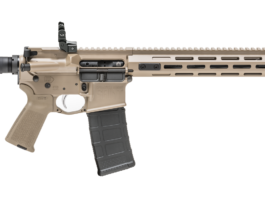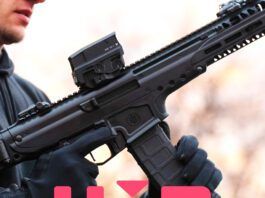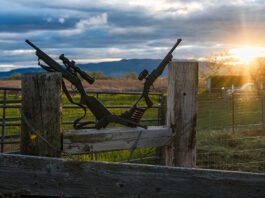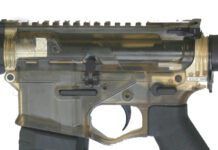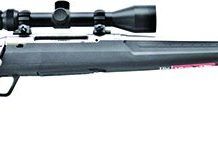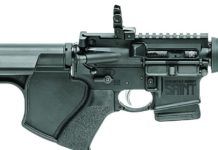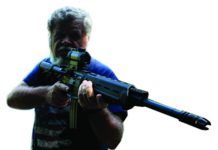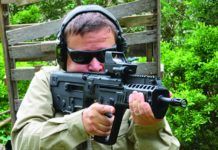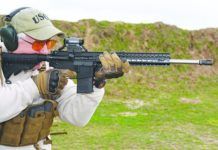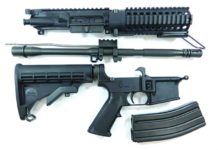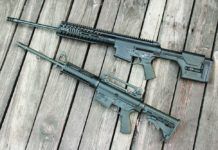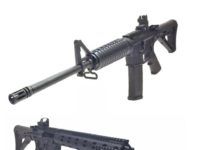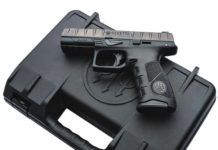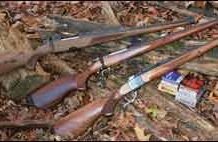American Tactical’s See-Into-It Translucent Rifle
Miller v. Bonta Decision
6.5mm Bolt-Action Rifles: Savage and Mauser Compete
Recently, at one of his favorite shops, a Gun Tests rater saw that one of his friends, a 70-year-old shooter still going strong, was looking for a "long-range" rifle. Long-range rifle shooting seems to be quite popular. We don't necessarily mean Camp Perry-type shooting, but ordinary shooters wishing to fire their rifles at distant targets and hit the target more often than not. With a wide range of 6.5 Creedmoor ammunition and the introduction of nine new rifles from a single maker in this caliber, we feel that the 6.5 Creedmoor is likely to remain popular for many years. The cartridge is touted as highly accurate, with low recoil, and enough velocity to consistently kill deer-sized game cleanly with a well-placed shot. The 6.5 Creedmoor also offers long-range efficiency with less component expense for handloads, not to mention lower recoil than the 308 Winchester or 7mm Remington Magnum.
Because of the friend's interest, we elected to test two new rifles in 6.5 Creedmoor and a third in another midrange offering, the 6.5 Precision Rifle Cartridge, introduced by Hornady. The two "Creeds" were both Savages. The first was the Axis II XP Stainless Bolt-Action Rifle with Scope 57289 in 6.5 Creedmoor. The Savage Axis II is the newest development of the Savage Axis line, a package gun. Package guns are simply affordable rifles supplied with scope rings and bases and a rifle scope. The buyer saves considerable amounts of money by purchasing the package versus purchasing each component separately. The rifle will have been mechanically bore-sighted by the manufacturer. In general, these rifles offer good value and save both time and money compared to obtaining and putting together your own package.
The second was a Savage 110 Apex Storm XP 57344 in 6.5 Creedmoor, substantially more expensive than the Axis. The Savage 110 differs considerably from the Savage Axis rifle. The receiver of the Axis is closed and easier to machine, while the Savage 110 is more traditional. A locking lug in the stock attaches to the Axis receiver, while the Savage 110 locking lug is sandwiched between the barrel and the action. The 110 action has more leverage and primary extraction seems better, although the practical difference may be difficult to prove.
Though the 6.5 Creedmoor is increasingly popular, the 6.5 PRC may become a viable cartridge for many users. The 6.5 PRC seems unlikely to be chambered in anything but bolt-action rifles, and we felt this a good opportunity to test a rifle we have not yet put through the grueling Gun Tests procedure, the Mauser M18. This rifle came chambered in 6.5 PRC, allowing us to gauge the difference in accuracy, power, and recoil between this cartridge and the 6.5 Creedmoor. The rifle was fired with the Hornady 6.5 PRC Match load, one of only two available, both manufactured by Hornady. Each box of 20 6.5 PRC rounds cost $31 from SportmansWarehouse.com.
There are also those who flatly state the 6.5 Creedmoor will do nothing the ancient 6.5x55mm round will not do, so we added a rifle chambered in the latter cartridge to give us some historical perspective. There are a few current rifles chambered for this cartridge, but we found an original Mauser rifle, manufactured in 1895, chambered for the 6.5x55mm Swedish, also known as the 6.5x55mm Swedish Mauser, and sometimes called the 6.5x55mm Mauser. The round first appeared in 1891, according to Cartridges of The World's 16th Edition. We are not collectors per se, but we like testing viable hunting rifles to see if the new stuff gives any better performance than the oldies. A collector may turn up his nose at the humble sporterized Mauser, but we found it to be a great light rifle for woods hunting.
Rifles Ready for All 50 States: Springfield, Troy, and Uintah
Innovation in firearms design has always meant finding a way to make guns more accurate, more reliable, less expensive to produce, and for the end user, easier to operate and maintain. And when it comes to trying to satisfy the restrictive demands of different state laws, the word innovation can once again be applied. Naturally, we'd like to see talented people work toward solutions without so much regulation, but we also wondered if makers seeking ways to satisfy the legalities of certain policies, a better firearm, or at least a promising new design, would emerge.
For insight into the world of regulated firearms manufacture and sale, we visited Todd and Amy Arms & Ammo in Petaluma, California. A family-owned full-service gun store run by retired Marine Todd and his wife Amy, their bustling shop serves as the epicenter of gun goodies in the more-gun-friendly area of Northern California. At Todd and Amy's, we learned that several inventors have been tackling the problem of providing workable solutions to producing 50-state-legal long guns for some time, including fixed magazines, variations on the pistol-grip stock, and even pump-action designs. In this test, we will look at three production rifles that incorporate elements of AR-type-restricted design found in states such as California, New York, Maryland, New Jersey, Illinois, and others. Because of constantly changing laws in these states, you must know your local regulations to see if a particular rifle conforms to your state's regulations. We do not guarantee these firearms will remain legal to own in any state, so check before you buy.
Our first choice was the $1135 CA Compliant "AR-15" Saint from Springfield Armory chambered in 5.56mm/223 Remington and featuring a full-float barrel.
Next was a pump-actuated "AR-10" from WorldofTroy.com chambered in 243 Winchester. List price of the Troy Pump Action Hunting Rifle was $899.
Our third test gun was a full-length bolt-action rifle from Uintah Precision chambered for 6.5 Creedmoor. Why is a bolt-action rifle in this review? Because the threaded barrel, upper, and handguard are configured as an AR platform that was designed to fit an AR-10 lower. Uintah sells the upper alone for $1295, but they were able to supply a matching lower so we had a complete rifle for our tests. Therefore, in the Uintah's specifications chart, the term "as tested" denotes measurements taken for the upper receiver only, as your lower may vary.
For ammunition supply we relied heavily on new selections from Black Hills Ammunition. Black Hills is a family-owned business that came to prominence by developing a 223 Rem. load topped with Sierra's 77-grain bullets for the U.S. military, therefore vastly improving the stopping power of the select-fire M16 rifle and its semi-auto civilian-version AR-15. Our Springfield Cal-legal Saint was stoked with four different rounds manufactured by Black Hills ammunition, ranging in bullet weight from 60 grains to 77 grains. Much of Black Hills production still relies heavily on military contracts, and this stamp of approval is why we so often favor their ammunition.
Black Hills has lagged noticeably behind other makers in offering 6.5 Creedmoor (or 6.5 CM) commercially, and now we think we know why. As of this writing, it has been announced that SOCOM, i.e. USSOCOM (Special Operations Command), is evaluating chambering 6.5 Creedmoor and phasing out the use of 7.62x51 (308 Winchester) ammunition in AR-10-type rifles. The Uintah rifle was fed Black Hills 143-grain and 147-grain ammunition, plus 140-grain rounds loaded by Hornady. Our pump-action Troy rifle was treated to three rounds from Black Hills Ammunition, each topped with Hornady bullets. The 243 Winchester ammunition featured Hornady's 95-grain Hornady SST, 80-grain GMX, and 58-grain A-Max bullets.
To ensure that our rifles had the benefit of high-grade optics, we relied upon the Nightforce ATACR 5-25x56mm SFP Enhanced riflescope (No. C554), featuring 0.10 Milradian click adjustments and extraordinarily clear glass. The reticle was illuminated by pressing the button at the center of the parallax adjustment turret, but "Enhanced' might very well refer to the interaction of the big, bold reticle constructed with fine lines, maximizing the capabilities of second-focal-plane design. Overall construction was robust, but relatively compact. We also tried out the Nightforce SR 4.5x24 Competition riflescope designed for the High Power Service Rifle division when it occurred to us that the California Legal Saint AR-15 may be the gun of the future for competitors in California.
Affordable Home-Defense Rifles: AR-15 or M1 in 30 Carbine?
When we evaluate firearms, there are guidelines we follow. Some of the projects are a result of market forces, where we are guided by what is new in the market place. Then there are reader requests. The following evaluation combines those arenas. Readers have shown interest in the M1 30 Carbine because it is a lightweight, handy rifle with historical overtones that shooters of a certain age respect. Accordingly, we have done comparisons of the rifles head to head and also ammunition testing.
Likewise, we have extensively tested AR-15 rifles and ammunition. So, coupled with experience in handling both rifles and the preference of some of the raters, we cooked up an AR-15 versus M1 Carbine shoot-out, with a slant toward inexpensive rifles for home defense. The M1 Carbine is fairly inexpensive in most examples, including good-quality modern reproductions such as the Auto Ordnance. Until very recently when regulatory bans began pointing anew at the semi-auto rifle, the AR-15 had been increasingly affordable, and we even saw something of a price war going on as late as January 2018. So, with a budget theme in mind, we chose two rifles for a new shooter on a budget and limited the spend to $800, including a reasonable number of magazines and a credible ammunition supply. Counted in this evaluation were the opinions of inexperienced and female shooters, the latter of which we listened to carefully to find a combination of recoil, muzzle blast, and firearm weight the distaff gun owner might prefer.
Some prefer a long gun for home defense for its power and accuracy, and the fact that handguns require time and inclination to master, a rifle can be an easier-to-learn tool, especially if area defense is also a consideration — that is, your yard is pretty large or if roaming predators, such as coyotes and feral dogs, are a consideration. A hard-hitting but light-kicking rifle can give results much beyond what a handgun can do for most shooters, if the rifle is reliable and accurate enough.
The ammunition testing we have previously done in each caliber is an important part of the summary of facts in this feature. In terms of power, the 30 Carbine round in its most-common size, 110 grains, runs slightly behind the standard 223 Remington in a 55-grain bullet. But power isn't the only consideration for someone using a rifle inside a home. Too much penetration is a problem. Choosing the right round is crucial to balance what's needed to stop the fight and what's too much. In previous tests, we found the Hornady 110-grain Critical Defense 30 Carbine round produced 1980 fps and the resulting energy of 957 foot-pounds. Shot into water, that round terminated with an expanded width of 0.47 inch and weight retention of 100%. It penetrated 20 inches of water. A Hornady V-Max 223 Remington load with a 55-grain bullet sped along at 2890 fps and produced muzzle energy of 1019 foot-pounds. That might worry the home defender, but this particular round finished with an expanded width of 0.44 inches of the largest fragment. It retained 50% of its weight and only penetrated 10 inches in water. The AR, again, has the edge because it's possible to tailor the load to the home, and that's not as feasible with the 30 Carbine rounds.
How do these rifle rounds stack up to some common handgun loads? They're much more powerful. As noted above, the 30 Carbine Hornady FXT generates muzzle energy of 957 foot-pounds and the 223 Hornady V-Max 1019 foot-pounds. In comparison, a Double Tap 10mm 135-grain round generates 1555 fps and 725 foot-pounds of energy. A Black Hills 357 Magnum 125-grain round running 1430 fps makes 567 foot-pounds of muzzle energy, and a Black Hills 45 ACP 230-grain JHP clicking along at 850 fps makes a paltry 369 foot-pounds of muzzle energy.
So with those facts in mind, we compared an Israeli Arms International M1 30 Carbine and a home-built AR-15. Average price at outlets was $480 for the 30 Carbine. Also, we found a Universal Carbine in a local shop for $425, and average price for a new Auto Ordnance 30 carbine was $775. We found a new Del-Ton AR-15 for $399 new in the shop. There are many good AR-15 rifles going begging at the beginning of the year for $600 and less. This is a turnaround from a year ago. So, a clear winner on the price scale goes to a budget AR, at least until a new buying boom changes that. For more stable pricing, we chose to test a gun we built ourselves. The test AR-15 rifle consists of an Aero upper and receiver, Brownells barrel, and Brownells bolt. The parts priced out to $600, and we got what we consider to be an average rifle with good components. We realize you can go as high as you want on the AR-15 and spend several thousand dollars, but that isn't what we are doing in this report.
Running the Bullpups: IWI, Kel-Tec, Steyr, and FN Compete
Bullpups were designed for close-quarters battle (CQB) use in cramped environments where a longer weapon can be a liability. They are smaller and more compact than the typical AR-15 rifle. What also differs is how a bullpup functions. These firearms are configured with the action located behind the trigger group. Your nose rests above the action, not behind it like with an AR or AK. That means the magazine is aft of the trigger, not forward. Thus, your reloading technique changes. Because the action is housed in the buttstock, the overall length is reduced, yet a bullpup still deploys the same barrel length as a civilian AR-15. The balance is different with a bullpup, with the weight of the rifle in the butt, not forward of your firing hand. The ejection port is located in the butt, and each bullpup we tested had a different philosophy on how and where empty cases should be dumped. The muzzle is likewise closer, so reaching out with your support arm and pulling the rifle into your shoulder — like with an AR — is not possible, but the bullpups offer other support-grip options.
Basically, then, everything from reloading to grip and handling changes when running a bullpup, so we wanted to see which bullpup we could adapt to more easily. Our quartet of bullpups included three chambered in 5.56mm, which was the IWI Tavor X95 XB16, the Steyr AUG A3 M1, and Kel-Tec's RDB. The fourth bullpup was the FN Model PS90 Standard chambered in 5.7x28mm. This is a nice sampling of bullpups because the AUG could be considered the Rolex of bullpups, while the Kel-Tec is the Timex at a much lower price. All performed without malfunctions, so they all took a licking and kept on ticking. One, the IWI, was modular and offered easy caliber conversion. All were optics-ready except the AUG (pronounced "A-U-G" not "awg"), which came from the factory with an optic. One, the FN, we had to study to even determine how to pick it up and shoulder it, but when we did we experienced a clear engineering solution to bad bullpup ergonomics. With the Kel-Tec, we ended up calling it the working man's bullpup. Nothing fancy, but it kept pace with the other three. In hand, the bullpups feel like an AR-15 short-barreled rifle, or SBR, which require special tax stamps to own.
We tested all except the AUG with either a SIG Romeo4B or a Mepro Tru-Dot RDS. Both are red-dot sights that excel at close-to-medium range. At ranges out to 100 yards, the dot suffices for most targets, but a crosshair reticle would shrink groups. The Romeo4B allows the user to toggle between four different reticles: 2-minute-of-angle dot, 2-MOA dot with ballistic holds, 2-MOA/65 MOA Circle Dot, or 2-MOA/65 MOA Circle Dot with ballistic holds. The ballistic holdover points are calibrated for 5.56 NATO and 7.62x51mm NATO rounds. A feature we liked was the activated motion sensor that immediately powers up illumination when the red dot senses motion and powers down when it does not to extend battery life. The Mepro Tru-Dot RDS we like and have used it for a number tests on AR-style firearms. It features a 1.8-MOA dot reticle and is constructed with an aluminum body and tough polymer frame around a large viewing window. This sight is easy to use when shooting with both eyes open. It runs on one AA battery, and you don't need any tools to change the battery or adjust the sight. It also turns off when not in use to conserve battery life. Both are good choices for AR applications, and as we found out, these bullpups, like ARs, have a straight comb and optics needed to be mounted high. Be aware that a bullpup is capable of hitting targets at the same ranges as an AR-15 with an appropriate optic.
Two of the bullpups — the IWI and Kel-Tec — are compatible with standard AR-15 magazines, which we appreciated since we have plenty of AR-15 magazines on hand. We used Brownells' aluminum-body magazines (Brownells.com, $14) Magpul Pmags (Brownells.com, $12.30), and Hexmag tubes (Brownells.com, $12); all were 30-rounders. The AUG and FN used proprietary magazines. Like an AR-15, the FN, IWI, AUG, and Kel-Tec allow the operator to keep his firing hand on the grip while performing a reload with the support hand.
The three brands of AR-suitable ammunition we tested included Aguila 5.56mm NATO with a 62-grain FMJ bullet, 223 Remington Federal Fusion loaded with a 62-grain soft point, and SIG Sauer's 223 Remington ammo loaded with a 77-grain Open-Tip Match (OTM) bullet. For the FN, we used FN 5.7x28mm 40-grain V-Max and Federal American Eagle 40-grain FMJs. We noticed big differences in recoil and muzzle blast between the 5.56 NATO and 5.7x28mm ammo. The 5.7x28mm ammo was similar to shooting 22 Magnum ammo — minimal recoil and not as much muzzle blast as the 5.56mm NATO.
AR-15 Carbines for Less Than $1300: The Winner is a Saint
A staff member recently paid $2300 for a complete AR-15 carbine without regret. But you may have noticed complete uppers selling for as little as $400 during the last rounds of holiday sales and complete carbines selling for less than $700. Why pay more? One answer would be to take advantage of the latest technology in terms of manufacturing, helpful features and improved ammunition. Forged rather than cast aluminum is now the standard, and machining is more exact thanks to computer numerically controlled (CNC) automation. The efficiency and versatility of barrels have been upgraded to take advantage of heavier bullets able to land a more effective blow at greater distance. Barrels with twist rates of 1:8 inches and even 1:7 inches have replaced the original-issue lands and grooves that spun the bullets at a rate of 1:9. Handguards are now modular platforms for lights, lasers, and sights, and ambidextrous fire controls are becoming more popular as well.
With the desire for a more up-to-date AR-15, we went shopping and found that we didn't have to break the bank — just get comfortable within a price range of about $900 to $1250 dollars. What we came up with was three AR-15s with upgrades that distinguished them from more traditional models.
Takedown ARs from DRD, Ruger, Windham: Who Takes the Cake?
Espionage novels and movies are filled with rifles that are transported in a brief case, quickly assembled, then used to fire incredibly accurate shots. But is the ability to transport a disassembled AR in a small case or knapsack more intriguing than practical? Couldn't an AR already be considered a takedown rifle? Can't you just disassemble the lower receiver from the upper receiver and tote the two pieces in a duffle bag? These were a few questions team members had as we started looking into takedown AR-15s.
On one side of the debate, a takedown AR can be discreetly carried without the normal gun case that announces to all what is inside. A takedown AR is something one might consider adding to his bug-out gear should flood, fire, or worse coming knocking on the door. Takedown ARs also have the ability to swap calibers, allowing a user to perhaps opt for 300 AAC Blackout on a pig hunt, use the 5.56mm NATO for home defense, and 9mm for low-cost training. This caliber-swap feature gives these ARs the ability to use whatever ammo is available at the moment. We've all experienced the ammunition shortages of the recent past, and there is no reason to think it won't happen again. These ARs can feed whatever ammo is available. Another plus on the takedown AR side is easier cleaning.
On the other side of the debate, parts that are assembled and reassembled wear faster than parts that are fixed, and the more complicated a design, the more likely it is to break and the harder it is to get spare parts. Also, we wondered how zero might shift when removing then replacing the same-caliber barrel? And, how would a different caliber affect point of impact? Of course, price is always a consideration, and the cost of these takedown ARs is high — more than four times the cost of an entry-level 5.56mm AR priced at about $550. Can't a shooter just buy two rifles and set them up with optics at the same cost or less?
To answer these and other questions, we gathered three models from DRD Tactical, Ruger, and Windham Weaponry. These manufacturers have taken the modularity characteristics of the AR to a new level, each offering its own unique takedown design. Operationally, the DRD and Windham are direct-gas-impingement models; the Ruger uses a piston system.
All in, these takedown rifles get smaller by separating the barrel from the rail, which we estimate as a reduction in length of about 8.5 inches. With all three takedown ARs, the rifle is broken down into three main components. One thing to note: The rails or handguards on these rifles are not compatible with aftermarket parts. You must use the handguard the AR is shipped with because it is a key part of the takedown design. You can, however, customize these ARs with other aftermarket parts like stocks, pistol grips, triggers, sights, controls, muzzle devices, and so on.
DPMS and POF 308 Semi-Autos: Heavy Hitters, or Just Heavy?
The last five years have been a roller-coaster ride for the gun industry, with an emphasis on AR-style rifles, which at one point were sold out nearly everywhere and were often selling above MSRP when you could find them. Now, AR sales are mostly down, except for a segment of the market that seems steadily abuzz, the larger caliber ARs, most commonly the 308 Winchester chambering. Most of the larger population of AR-15 owners can't be sold on the larger chambering simply because of heavier rifle weights, but steadily emerging, is a group of gun enthusiasts who seem not to be deterred by the extra weight. This is evident by the many 308-caliber AR-style guns on the market today made by many gun manufacturers, including Patriot Ordnance Factory and DPMS. These firms are not newcomers to this market; DPMS, in fact, was one of the first companies to develop and manufacture a line of 308 Win. AR rifles about 15 years ago.
We approached this test as if we were already gun owners, and we were considering whether to add a .308 semi-auto to our existing collection to add range above and beyond what our 5.56/.223 semi-autos could develop. So we chose two slightly different configurations to see what seemed like the better mix of weight, handling, and recoil. One of our test guns was a DPMS LR-308-AP4, which has an MSRP of $1269 in its base configuration (with an aluminum free-float handguard), and a suggested retail price of $1399 with an optional free-float quad-rail, as tested here. It is a 16-inch-barrel carbine with a direct-gas-impingement operating system. We pitted it against a Patriot Ordnance Factory Gen3 P308-20 BLK with an MSRP of $2599. This 20-inch-barrel rifle uses a 3-position short-stroke gas piston system to operate the action (your choice of normal, suppressed, and bolt-action operating modes).
We used a three-person test group for this evaluation, all proficient shooters in their area of interest. One was a longtime AR-15 5.56 rifle shooter and collector. The second team member prefers large-caliber bolt-action rifles, and the final member mainly shoots 22 rimfire rifles and pistols. Would trigger time behind either of these 308-caliber AR-style rifles convince them to part with a lot of money to buy one?
Two Ways to Go Lighter with An AR: M&P Versus Daniel Defense
Most gun owners choose a handgun or a shotgun for home self defense, with fewer of us picking a rifle for that job. Part of the equation certainly has to do with the portability and maneuverability of the handgun in tight spaces and, in most homes, short hallways. With a 9mm Luger or 45 ACP semi-auto or a 38/357/44 Special wheelgun, we believe we can shoot well enough with enough power and enough capacity to keep firing until the threat stops threatening us. Handguns are also easy to secure by safe or lock from nosy kids who ought not be looking in mom or dad's night stand, but who often do anyway. Other homeowners prefer the snick-snick of a pump or autoloading shotgun in 12 or 20 gauge (the gauge doesn't much matter on the receiving end). But rifles, in particular AR-15s, deserve at least a look in this area because they can be short enough, light enough, deploy enough capacity, and be powerful enough where it counts. Oddly, it is power that stops many self-defense shooters from considering the 5.56 NATO-chambered rifle for home defense, because they don't want to have to worry about penetration through sheetrock, wallboard, or even bricks. According to at least one expert, the trick is to choose the right bullet for the self-defense rifle, because the rifle itself has a lot of advantages over a handgun or shotgun.
J. Buford Boone III, owner of Boone Ballistics in Northport, Alabama, provided expert testimony for the NRA's litigation wing to challenge state attempts to restrict or ban AR-15s (Friedman v. Highland Park, NYSRPA v. Cuomo, Shew v. Malloy, and Kolbe v. O'Malley [now Hogan]), with the banning states' arguments being that civilians shouldn't own long guns that look like military rifles. NRA countered that the prevalence of the AR as a home-defense choice isn't known, and that the landmark Heller decision protects firearms that could be used by civilians in and around the home. That's where Boone's expert report comes in.
Boone has a list of ballistics credentials a mile long, one of which is that he is a retired Supervisory Special Agent (SSA) of the Federal Bureau of Investigation (FBI), and had primary oversight of the FBI Ballistic Research Facility (BRF) from April 1997 to August 2012. Boone said in his expert report, "The AR-15 rifle has characteristics that make it particularly suitable for defensive purposes."
So with Boone's endorsement in mind, we went looking for a couple of rifles that, with training, could be used by a range of folks — from husky men to small-framed women — in the close confines of a home. That meant the shortest non-SBR barrel, an adjustable-length buttstock, the ability to be fired accurately and fast with open sights or optics out to 25 yards, and either the ability to accept a light or have a handguard shaped appropriately so a light could be held with the front hand. We found two very different approaches that, naturally, cost very different dollars.
Beretta Unveils APX Striker Gun
Beretta's APX, a new striker-fired full-size pistol in 9x19mm, 9x21mm IMI and 40 Smith & Wesson cartridges, debuted at the 2015 International Defence Exhibition & Conference IDEX expo in Abu Dhabi Feb. 22.
"IDEX is one of the first venues where defense contractors present their wares to worldwide military customers and Beretta felt this was the ideal environment to present the international offering of its APX pistol," said Carlo Ferlito, general manager of Beretta and Beretta Defense Technologies (BDT) vice president.
Beretta intends to market a variant for the commercial market later this year. The new Beretta APX has an ergonomically-molded reinforced polymer frame fitted with a built-in MIL-STD-1913 Picatinny rail, interchangable backstraps and grip panels, and a modified Browning locking system. The APX is 7.56 inches long with a 4.25-inch barrel.
The trigger can be considered a light double action, with a 6-pound break, 0.2 inch of travel, and a 0.12-inch reset. The rear portion of the striker slightly protrudes from a round slot on the back of the slide as a loaded-chamber indicator.
The slide is machined from stainless steel and has a nitride coating that reduces glare, scratches, and corrosion. Other features include wide front and rear slide serrations, three-dot sights dovetailed into the slide, and no manual safety save for a Glock-style trigger safety.
Ferlito said, "Beretta waited to enter the striker-fired market until we had a pistol we knew would meet the needs of the operator. The APX has been more than three years in development. We tested it extensively with professional end users and incorporated that feedback at every opportunity. The result is a pistol platform that delivers superior performance in durability, reliability, accuracy and ergonomics."
A slot on the frame allows the use of a tool to decock it before it can be field-stripped by operating a lever found on the left side of the frame.
An optional manual safety system will be available upon request, consisting of a frame-mounted two-position switch. A reversible magazine-release catch and a factory ambidextrous slide stop/hold open release lever help make the pistol suitable for left- or right-handed shooters.
Supplied black double-stack metal magazines have polymer bottom pads and offer 17-round capacities in 9x19mm NATO and 15-round capacities in 9x21mm IMI (9 Italian) and 40 Smith & Wesson.



























